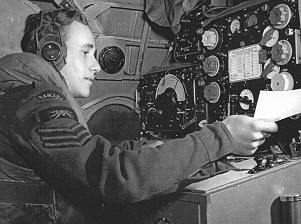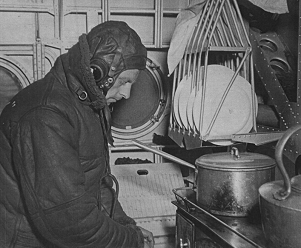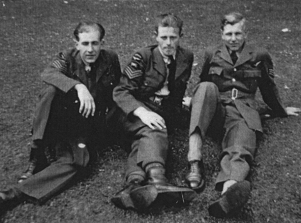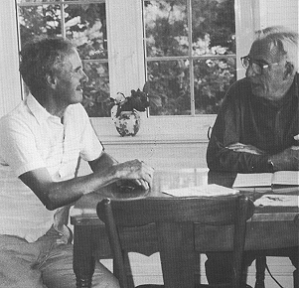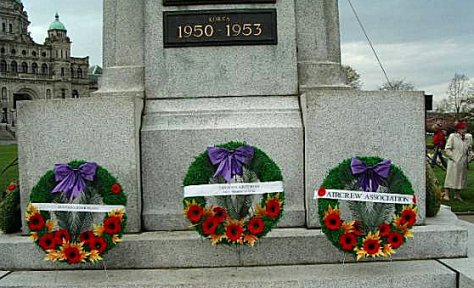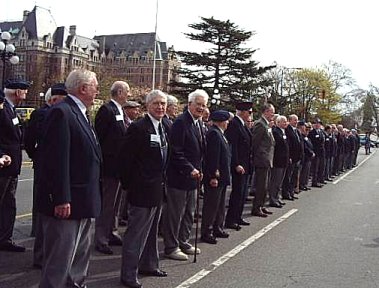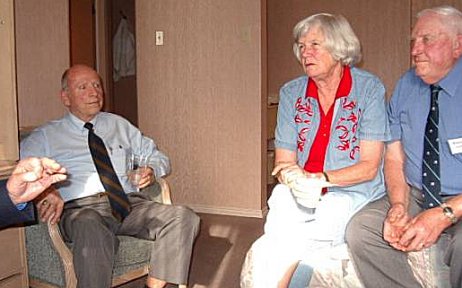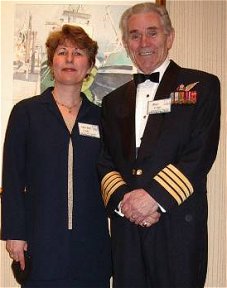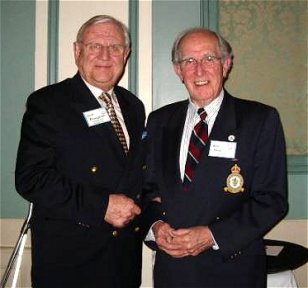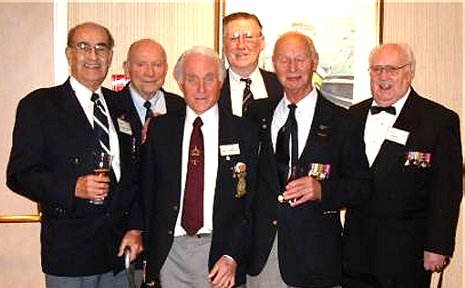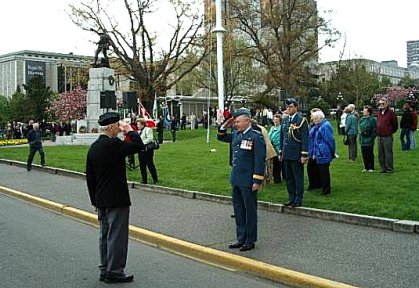Forces: Land ~ Air ~ Sea ~ Home
A MILITARY TRIBUTE WEBZINE . . . AS YOU WERE . . .
www.hillmanweb.com/flash
Compiled by Bill Hillman
FLASH. . . Editor and Webmaster: Bill Hillman: hillmans@wcgwave.ca
www.hillmanweb.com/rcaf/mag
MAY 2003
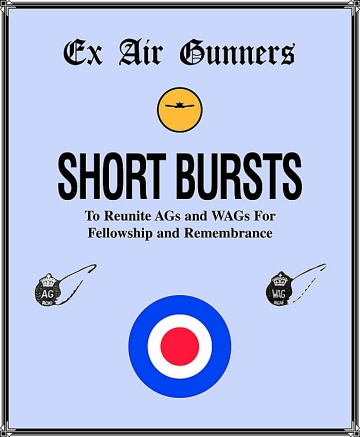
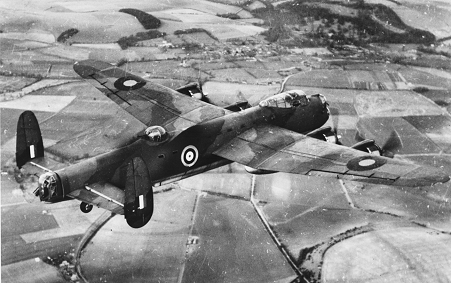
WITH RADIALS
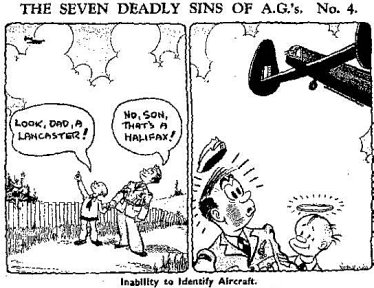
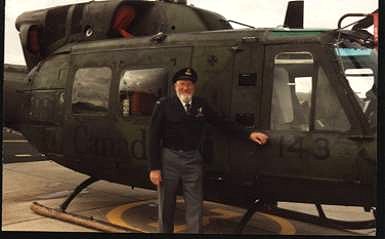
Phil Dubois
427 Sqdrn. 50th Reunion Nov./1992 Petawawa, Ont. (No beard now)
Phil Dubois – Gibsons B.C.
A WING AND A PRAYER
Our crew had been on a weeks operational leave. The date was 22/12/43. Several of us had arranged to catch the 3:30 p.m. train from King’s Cross to York. We arrived in York to have a few pints before catching the milk train to Leeming. None of us were feeling too much pain when we passed through the main gate. There was an aircraft coming in to land. I made a remark that “The bastard is going to prang”, we were even betting ten bob one way or the other. We then heard a bank, crash, screech which tended to sober us up;, especially the next morning when we discovered it was our beloved Y-York, mostly referred to as Yehudi, the Gremlin painted on the nose. A new pilot on the squadron, F/Sgt. Rex Clibbery was returning from a Bullseye and forgot to lower the undercarriage. He badly bent our aircraft and it never flew on ops again. Yehudi was a Halifax V. By the time she was repaired we had converted to Halifax IIIs.
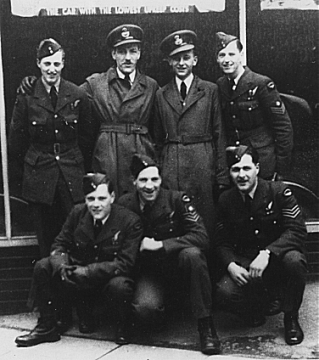
Back Row – Sgt. Gibbs, P/O Deegan, P/O Smith, F/Sgt. Axford (KIA)
Front Row – WO2 Bob Anderson, F/Sgt Phil Dubois, Sgt. Corbiell
This photo was taken by P/O Smith, Mid-Upper of S/L Lairds crew. Shortly before the raid on Nuremberg 30/31 March /44 Jim Moffat was the only survivor of their crew. One of our worst Ops.
29th. Dec/43 we were on the Ops board for operations that night. We were assigned “W-Willie” LK915, our Flight Commander S/L Laird DFC’s aircraft. At briefing we found the target to be Berlin, our third trip to the big city. Our second dickie was Rex Clibbery. There was no hard feelings about him pranging our kite and Rex turned out to be a real Squadron character. Both he and his mid-upper gunner, Sgt. R.E. Quale won the DFM over Magdenburg on the night of 21/01/44.
We took off at 20:00 hrs. We were well into Germany in the area of Hanover when our Mid-upper Gunner, Johnny Gibbs told me there was another Halifax on our port beam. It was slightly above us and flying slightly to starboard. We could both see that there was no fear of collision. When it was directly above us our Flight Engineer looked up through the astrodome and yelled, “DIVE” We were at 18,000 feet. Our Skipper, P/O Bob Deegan pulled up at 14,000 feet. The constant speed unit in the port outer went U/S. Deeg managed to feather it, but we were unable to gain altitude. By then we were well behind the bomber stream and had no desire to fly over Berlin at 14,000 feet by ourselves so decided to jettison our bombs live and return to base. There was a very large explosion when our 2000 pound bomb exploded.
Soon after we set course for the Dutch Coast the red fighter flares started dropping. At this stage of the war the fighter boxes were being manned by inexperienced crews, the experienced crews attempting to, and quite successful in intercepting the bomber stream with their Zahme Sau or Tame Boar method. We did have one night fighter come within 600 yards of us. I gave evasive action. The fighter had his navigation lights on. This was not an uncommon practice with German night fighters. While the Gunner’s attention was drawn to the fighter with it’s nav. Lights on, another one came in from a different direction and shot you down, however this was not the case. We were throwing window out like mad (aluminm foil to confuse the radar). I think it was an inexperienced pilot confused by the window.
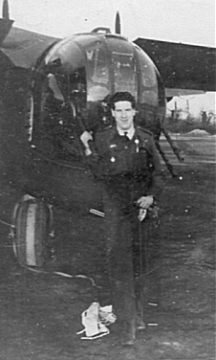
P/O Phil Dubois – Halifax III
420 Sqdrn. July/44
As we approached the Dutch Coast we were unable to maintain altitude on three engines and were down to 10,000 feet. At this time the starboard engine sprung a glycol leak and had to be feathered to maintain altitude. It then became a comedy of errors.
We had enough window for the trip to Berlin and back. Our Flight Engineer, Clem Corbiell, in an effort to lighten our load opened one of the top escape hatches and started throwing out whole unopened bundles of window. The first one struck the mid-upper turret giving Johnnie quite a scare. He then commenced throwing them out either side and in the darkness not knowing that he had severed both the pilot’s sending and receiving aerials which ran from the radio loop to both rear tail planes. Jim Smith, our radio operator was busy sending out S.O.S’s. Of course he was not on intercom so he did not know what was going on. We still had the incendiary containers. To lighten the load further the bomb doors were opened and Bob Anderson, our bomb aimer, jettisoned the incendiary containers. In doing so he loped off the trailing aerial. Smitty managed to locate his spare trailing aerial which had come loose from its mooring in our dive and was buried in the nose under piles of open window that had ended up in the nose when Deegan had pulled out of the dive. He managed to splice it on to what was left of his trailing aerial and continued sending S.O.S.’s. By this time we were down to 5,000 feet over the North Sea. The Port inner engine had overheated so much that it had burnt off the exhaust manifolds, or flame dampeners, only developing about one-half power, and was trailing an exhaust flame about 15 to 20 feet behind. Johnnie said he could read a newspaper in the mid-upper turret. We never considered removing the guns as we did not know if we were being tracked by a German fighter.
By the time we were half way across the North Sea we were at 5,000 feet and staggering through the air at 110 mph, just above stalling speed. I had no desire to ditch in the North Sea at night in the middle of winter. Smitty had managed to splice in the pilots sending aerial onto his trailing aerial, but not the receiving aerial. Deegan was calling “DARKIIE”, but not receiving an answer.
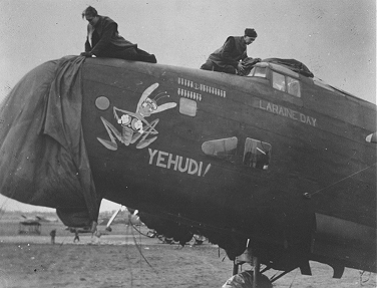
Corporal McMillan and Dusty Rhodes (Roads?)
Dusty was a bank manager in Calgary after WWII.
A great Ground Crew. YEHUDI was a good Gremlin.
This is the aircraft pranged by F/Sgt. Rex Clibbery.
We were down to 1,000 feet when the English East Coast was sighted. The Skipper told me to come out of my rear turret to the rest position as we may have to bail out. I was just over 6 feet tall and had difficulty getting out of the turret. I certainly preferred bailing out rather than ditching in the North Sea.
When I plugged into the intercom in the rest position, I heard US Army Station Bungay answering our distress call. Clem was trying to pump down the under carriage, but was quite exhausted from trying to lighten the aircraft. He told me years later that a big hand came over his shoulder and in a few strokes finished the job. He said, “that was your hand Phil.”
Bungay turned on its lights and, fortunately, we were lined up with the runway as the port inner packed up on the way in. Deeg made a successful one-engine landing. We had no brakes, consequently we ran off the end of the runway, but no one was injured.
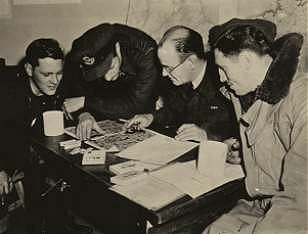
P/O Bob Anderson, F/L Bob Deegan, Intelligence Officer,
WO2 Phil Dubois, interrogation after a raid. (Note Sweet Cap cigarettes.)
Later in the day the CO and the Engineering Officer flew down in an Oxford. The E.O. said, “4 new engines.” They took our Navigator and Skipper back with them. That night the remainder of the crew headed into Norwich where Rex Clibbery entertained our gracious Yank hosts by singing many songs including “We were Flying F’n Fortresses at 40,000 Feet.”
The next day we were given railway passes to return to base. We got as far as Peterborough and Rex said there was no way he was going to spend New Years Eve on a bloody train. We booked into a hotel and spent the night in z pub. Clem said we had a good time and were invited to a house party after the pub closed. I was only 19 at the time, the youngest member of the crew, and after a few pints of beer my recollection was very hazy.
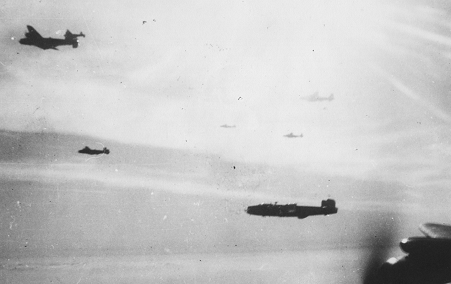
Bomber Stream. Halifaxes on way to Germany 1944
BRIDGING THE ATLANTIC
This is the first part of BRIDGING THE ATLANTIC
written by Norman Shannon for AIRFORCE Publication Winter 2000.
Hattie’s Camp wasn’t dressed for history that evening although many of the men wore a poppy. It was 10 November 1940. The 22 men who boarded the seven Hudson aircraft were about to challenge the Atlantic yet were glad to see the end of the airfield which consisted of a hangar, a control tower and two coaches in the Newfoundland railway siding, shortly after 9 p.m. Don Bennett sent the first Hudson snorting down the desolate runway which some folks were starting to call Gander. The others followed sending snow scudding across the swamp at Mileage 113 of the railway, and the band played, “Nearer My God to Thee.”
The selection was appropriate, considering the fact that the Hudsons were challenging the night and the Atlantic Ocean. Aircraft were so badly needed in England that some officials were willing to accept a 50 percent loss because that was the loss incurred when aircraft were shipped by sea.
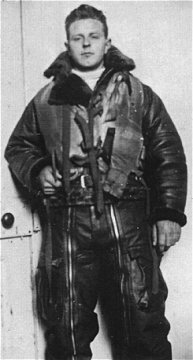
Don Macfie ready to do his bit for
King and Country
So much for the “Official” history. Many graduates from the Commonwealth Air Training Plan did not depart for England via Pier 21 Halifax, many were instrumental in flying much needed aircraft from Gander to UK. Let us listen to a Wireless Air Gunner who “worked” his way overseas on a Hudson aircraft.
Don Macfie writes:
We had just come up to Dorval near Montreal from our OUT where we had learned the knack of the Lockheed Hudson. We had about 60 hours as a crew, which is not much when you are setting out for the United Kingdom some 3000 miles away and across that stretch called the Ocean.
Bert Russell is pilot and Skipper of our brand new Hudson parked on the apron with Libs, Cansos, Mitchells, Dacotas, and the heck knows what else. Russ comes from Edmonton, married, University graduate. So far I’ve no complaint of him as a pilot, and we are getting confidence I him.
Then there is Ritchie, Jack, short and full of tricks and devilment with no apparent worry in the world, a grin which always reminded me of fox who’d just run off with the bait from the trap. He is the Navigator and master of all those pencils, maps, gadgets, up in the nose where he has a little room all to himself, and lots of windows where he can take in the view passing underneath. He comes from Windsor, and we are all the time hearing about how it is the best city in Canada. He is well educated, and about 23 years of age.
Lastly there is me, about which there is not much to tell. Worked at home on the farm up in the bush country of Ontario, quit school at about 11 years of age. Came out of the bush and joined up as an air gunner, getting in only because they were needing gunners at that time. It happened that I got sent to wireless school for some reason, where I did pretty well for myself and got sent to OUT at Debert N.S. for training as a ferry Command W/OP. I did pretty well there to. I’m 21, not much to get around, no dozen girls like Richie, I stay in and save my money.
June 2, 1942
Flew our overloaded new Hudson FH444 from Dorval to Gander Newfoundland. Here we find many of the chaps who had preceded us. We learned that Dezall, Gatehouse and Scarth never reached the UK and are down and lost. Scarth was a good friend of mine. We were given a good meal and a comfortable place to sleep.
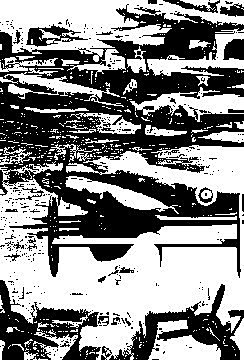
Aircraft at Gander Airstrip waiting to be ferried
to UK 1942
Got up about 10. In the afternoon bought a bunch of cigarettes at $1.00 per carton of 200. I bought 2400. We were briefed for the trip in the afternoon. The weather report is cloudy with some ice and it was up to the crew whether they went or not. Everybody decided to go. I was responsible for the food, thermoses and such items.
We took off at 9 p.m. We had such a heavy load that the aircraft seemed to be just up there kind of rolling back and forth like a water-soaked log about to sink. We crossed the coast of Newfoundland half an hour after take-off and headed out over the Atlantic for Ireland.. We had to start our climb immediately to get over the cloud.
June 4, 1942
I didn’t have much to do on the trip. Send call sign every two hours, and keep my ear open in between. The first thing to go wrong was the oxygen supply. We turned it on and in doing so Bert turned his valve out too far and couldn’t get it back in gain. Oxygen was blowing out at a great rate and we would have lost it all if I had not got to the main valve at the rear and managed to regulate the oxygen flow. It was rather tricky and at times we were not getting enough and felt woozy. Richie didn’t turn his on at all, He didn’t know he had to turn the valve on, just put his mask on and let it go at that. He came up out of the nose a couple of times and seemed to be acting funny. I noticed him crumple up his maps, break his pencils, and bite chunks out of his eraser, and wipe everything onto the floor. I went down in the nose and found his oxygen valve was not on. He said later that he got very sleepy and unconcerned, gave up navigating, and just sat there. When he was in this state he had come back to take a star shot through the astro dome, but breathed on the glass of the sextant and it immediately frosted over rendering it useless for the rest of the trip.
The uneven flow of oxygen had other effects. About four hours out, a gas tank ran dry and both motors quit. We went down in a dive toward the sea. Not knowing what had happened gave me quite a scare, I thought all was up with us. At 13,000 feet Bert started to come out of his oxygen deprived stupor and, seeing the big red light blazing at him switched over to the full tank and got us going again. This was to happen two more times on the trip.
It didn’t get very dark. Got into shades of twilight about 12:30 a.m. The light travelled around the horizon and the sun was up again at 3:30 a.m. At this time we were flying at 26,100 feet and just skimming the tops of the cloud and leaving a big ditch traced behind us. We had an exceptional ship, they usually couldn’t get that high with a load. It was 60 below up there and we seemed to be in a very unreal world. I came out of a drowse once to find a large icicle from my oxygen mask stuck to my knees. I also had to pump 110 gallons of fuel up from the bomb bay at a rate of six pulls on the pump per gallon. This was pure hell when you are oxygen-shy and freezing.
After nine hours and still over cloud we figured we should be getting somewhere but weren’t quite sure of our position. We just went by what bearings I could get on the radio. Finally we saw a hole in the cloud and came down. There was land. We breathed a sigh of relief. I got a fix that put us over the biggest lake in Ireland and got a QDM (course to steer) from Prestwick. In half an hour we were over Scotland I will never forget the pretty sight Ireland and Scotland made. We cut into the circuit and landed without permission because all our tank gauges were reading empty. We had about 15 gallons left. I had trouble with the radio telephone because of the Scottish accent of the operator. Our time for the trip was 10 hrs. and 15 min.
It is all over, and I feel at last I have done something. I guess I have eh?
